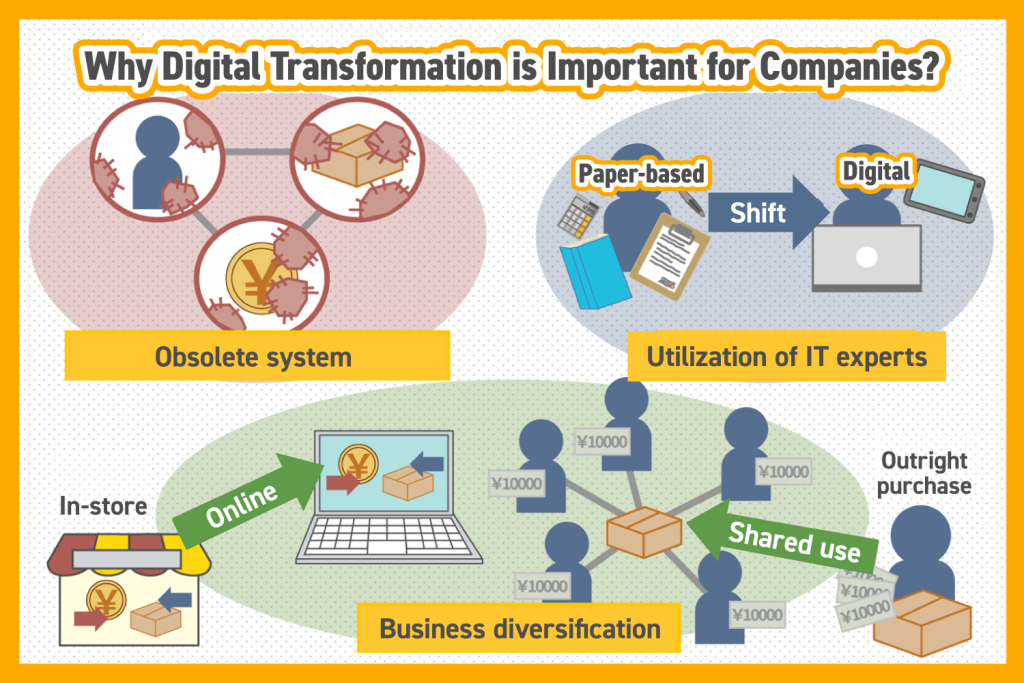Digital Transformation (DX) refers to the concept of realizing a better society through digital innovation. In Japan, attention on the potential risks arisen from the delay in digital transformation is on the rise when the term “2025 Digital Cliff” was first used.
This article defines digital transformation, and explore the background, reasons companies should engage in DX, and its utilization in the healthcare industry.
What is Digital Transformation (DX)?
DX is the abbreviation of digital transformation, referring to a concept involving societal transformation through the utilization of digital technology.
Proposed in 2004 by Professor Erik Stolterman of Indiana University, the concept rather refers to fundamental technological innovations that can overturn existing values, but not mere digital reform.
Why DX is Attracting Attention
In 2018, the Ministry of Economy, Trade, and Industry (METI) published the “DX Report,” summarizing the challenges Japanese companies may encounter in achieving DX*.
This report highlighted factors hindering DX, such as executives’ lack of insight and strategy for digitalization and obsolescence of existing systems. In particular, the report intensify attention by posing the “2025 Digital Cliff,” a looming crisis that could occur if companies are unable to realize DX.
*Source: Ministry of Economy, Trade, and Industry, DX Report 2.2 (Overview) (Accessed January 20, 2023)
What is the “2025 Digital Cliff”?
The “2025 Digital Cliff” refers to the following potential crises if companies fail to achieve DX by 2025:
- Inability to leverage data, rendering them incapable of adapting to market changes and losing in digital competition.
- Rising maintenance costs for legacy systems, hindering the continuation and succession of operational frameworks.
- Increased risks of data loss due to cybersecurity issues or system failures due to aging workforce and retirement.
If these crises come into reality, the resulting economic losses are estimated to reach up to 12 trillion yen annually.*
The same report emphasizes the importance of refreshing legacy systems as a key method to overcome the 2025 Digital Cliff.
*Source: Ministry of Economy, Trade, and Industry, DX Report – Overcoming the 2025 Digital Cliff and Fully Deploying DX (Accessed January 10, 2023)
Why Digital transformation is Important for Companies?

The need for companies to pursue DX is not solely about adopting digital technologies for new business models. As highlighted in the 2025 Digital Cliff report, failure to replace legacy systems may jeopardize the continuation of their business operations.
1. Addressing legacy Systems
According to the DX Report, approximately 60% of companies’ core systems have operated for 21 years by 2025. Continuing to use legacy systems hampers the ability to utilize big data effectively, making it challenging to sustain fundamental business operations. This could threaten the very survival of companies, underscoring the need for system modernization.
2. Leveraging IT Experts
To enhance global competitiveness, companies necessitate new business models using digital technology, which requires the utilization and development of DX and IT experts. Persisting with legacy systems hinders skilled IT professionals from engaging in cutting-edge technology.
Shifting these personnel from system maintenance to digital technology development enables companies to respond swiftly to market changes and develop innovative new products and services.
3. Adapting to Diversified Business Models
The evolution of digital technology has significantly changed business models, such as enabling online sales and promoting shared-use models instead of outright purchases. Additionally, new market entrants leveraging digital technologies can quickly dominate entire markets.
In a diversified market, companies must promptly meet consumer needs, making the promotion of DX essential.
How DX is Utilized in the Healthcare Industry
DX can help address challenges faced by the healthcare industry, including the declining birthrate, an aging population and a shortage of healthcare workforce. Below are two examples of how DX can be applied in healthcare:
Building Medical Information Networks
A medical information network is a system that allows hospitals, pharmacies, and nursing facilities to share and confirm patient information. If such a network can be established, it enables healthcare providers to access a patient’s medical records promptly, even if the patient transfers to another institution, ensuring appropriate care.
Sharing information not only between hospitals but also with nursing facilities and pharmacies will also enhance the quality of healthcare services.
Strengthening BCP with Data Centers (DCs)
Promoting DX in the healthcare industry requires data such as medical claims and patient records. However, storing such data solely on in-house servers poses a high risk of data loss in the event of a disaster, potentially undermining healthcare services.
Storing medical data in data centers minimizes the risk of data loss during emergencies, strengthening BCP and safeguarding operational assets.
DX Improves Efficiency in Healthcare Management
Digital Transformation is a concept that aims to transform society through the application of digital technologies. The promotion of DX is essential across all industries, including healthcare, where it can contribute to more efficient insurance operations and business management.
Medical Data Vision Co., Ltd. leverages medical databases to offer services such as ad hoc analysis and web tools. Please do not hesitate to consult us for any assistance in utilizing medical big data.




